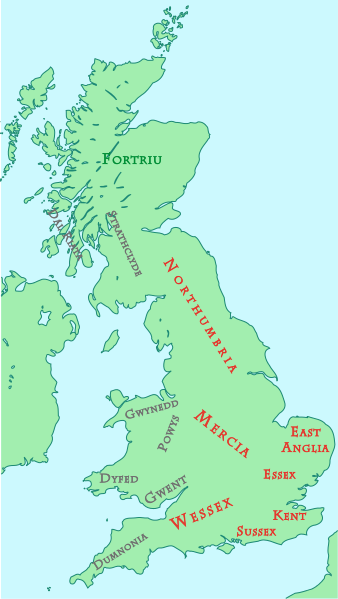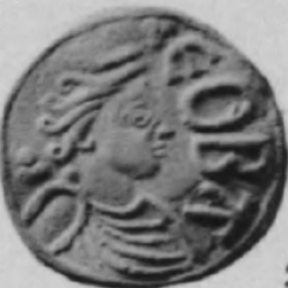
Newsletter
Yes! Send me my FREE short story collection and sign me up for those exclusive subscriber goodies!
We value your privacy, and will never spam you! View our privacy policy at lasmithwriter.com/privacy

Yes! Send me my FREE short story collection and sign me up for those exclusive subscriber goodies!
We value your privacy, and will never spam you! View our privacy policy at lasmithwriter.com/privacy
It’s not very easy to find information about the women of Anglo-Saxon times. But there are a few women we know about, because their names or histories, or both, have been preserved in works such as Bede’s Ecclesiastical History of the English People, or the Anglo-Saxon Chronicle. But there is only one woman who had coins minted with her name and likeness, in fact she is unique in that aspect for all of Western Europe for that time. She is Queen Cynethryth of Mercia (dates uncertain, possibly died AD 798).
We don’t know a lot about Cynethryth that is certain. It is possible, due to the similarity of her name to the wife and daughters of King Penda of Mercia (Cynewise, Cyneburh, and Cyneswith) that she was Anglo-Saxon and descended from him. There is a 13th century account that she was Frankish, condemned for a crime and set adrift in a boat on the open sea. She landed in Wales and was taken to Offa, where she pleaded that she was of the Carolingian royal house and had been persecuted by Charlemagne. Offa fell in love with her and subsequently married her.
However, this seems a little fanciful, and seeing as it comes from centuries after her life, I’m not sure we can entirely believe it. I prefer the other explanation, myself. At any rate, we don’t have a date for their marriage, but she first shows up in history as being witness to her husband Offa’s charters (documents that set out rights or privileges) after the birth of their first child, Ecgfrith, in AD 770. By AD 780 she is listed on some of the charters as “Cynethryth, by the Grace of God, Queen of the Mercians.”
 She appears in some of the correspondence of Alcuin, a cleric who was also a scholar, poet and teacher. He was also somewhat of a diplomat, it seems, who had ties between Offa’s court and the Carolingian Empire of Charlemagne. He almost certainly knew Offa and Cynethryth, and likely travelled between the two courts. In fact there are hints in his letters to others that he also had correspondence with Cynethryth, although no such letters have survived, unfortunately. He refers to her as the “controller of the household”, which echoes the role of the Carolingian queens, who were responsible for the management of the royal household.
She appears in some of the correspondence of Alcuin, a cleric who was also a scholar, poet and teacher. He was also somewhat of a diplomat, it seems, who had ties between Offa’s court and the Carolingian Empire of Charlemagne. He almost certainly knew Offa and Cynethryth, and likely travelled between the two courts. In fact there are hints in his letters to others that he also had correspondence with Cynethryth, although no such letters have survived, unfortunately. He refers to her as the “controller of the household”, which echoes the role of the Carolingian queens, who were responsible for the management of the royal household.
This reference to the Carolingian Empire is interesting. Charlemagne (AD 768-AD 814) was certainly the most powerful ruler in western Europe at the time. Offa was similarly one of the more powerful kings in Anglo-Saxon England, and the two kingdoms engaged in trade and other diplomacy together. In fact, in AD 789-90 Alcuin was involved in negotiations regarding the marriage of Offa’s son and heir, Ecgfrith, and Charlemagne’s daughter. There are no other kingdoms of the time that Charlemagne considered marriage alliances with, except for the Byzantine Empire, which shows the status of Offa at the Carolingian court.
However the marriage negotiations, almost certainly aided by Cynethryth, fell apart due to Offa’s insistence that they be tied to another marriage, that of one of Offa’s daughter to Charlemagne’s son. Kind of a package deal, so to speak. Perhaps Offa was getting too big for his britches on that one, however, and neither marriage alliance came to pass.
Alcuin also urges Ecgfrith, in a subsequent letter to the royal prince, to emulate the piety of his parents, Offa and Cynethryth, so it seems she must have had a good reputation. This was important to Offa, as he attempted to bring legitimacy to his reign and his heirs by contrasting it to that of his predecessor, Æthelbald, who was accused by church officials of stealing from the church and fornicating with nuns, among other things.
Cynethryth was also named as co-ruler with Offa by Pope Adrian I when he wrote to them regarding an ecclesiastical matter. So perhaps it is not surprising that Offa struck coins not only with his image, but with Cynethryth’s as well. However, it is also possible that Offa was styling himself as a Roman-type emperor, as the coins are similar in design to coins that Roman emperors had struck in the names of their wives. Whatever the reason, it still remains highly unusual that a queen consort (one who is queen by virtue of being married to the legal king, not because she is queen herself by birth) have a coin struck in her honour.
Coins themselves were not uncommon during Anglo-Saxon times. Mostly they were made of silver, such as the ones that bore Cynethryth’s image. The coin depicts a bust of Cynethryth in profile, wearing a tunic with round fasteners at the shoulders. Her hair streams back from her head in stylized waves, and she wears a simple diadem on her head. On the front of the coin, beside her image, is the word EOBA, which was the name of the moneyer who struck the coin (typical of the time). On the back is CENEÐRYÐ REGINA (Queen Cynethryth), and there is a stylized M in the middle for Mercia.

Cynethyrth’s coin. Image from Wikicommons
Offa died in AD 796 and Cynethryth, like many royal widows of the time, retired into religious life. She became abbess of a monastery of Cookham and also managed the church at nearby Bedford, where her husband was buried. She is still alive two years later, in AD 798, where she is mentioned in a dispute over church land with the Archbishop of Canterbury during a synod that year. But then she disappears from history, and we assume that she died that year, but of course we cannot know for certain.
In the 13th century Cynethryth’s reputation is sullied in a literary history called The Lives of the Two Offas, written by a cleric in the monastery of St. Albans, which had been founded by Offa. In this history, Cynethryth is described as being the evil power behind the throne, urging her husband to kill King Æthelbert of East Anglia, who was a suitor to their daughter. The story recounts that Offa refused to do the deed, so Cynethryth took it upon herself, luring the hapless king to her bedchamber where she and her handmaids suffocated him (or, in another version, Æthelbert was beheaded).
An entry in the Anglo-Saxon Chronicle does briefly mention the murder of King Æthelbert, saying the deed was done on the orders of King Offa in 794. It is possible that the revised history was written by the monks of St. Alban to polish their founder’s reputation and throw the blame on his wife, instead. Easy enough to do when everyone involved was long dead.
Legends aside, I hope you agree with me that Cynethryth was a fascinating figure. Her coins point to her importance at the time, and give us a little more knowledge about the lives of royal women in Anglo-Saxon times.
Featured image from medievalists.net. Technically this is Queen Emma, mother of Edward the Confessor, but hey, I couldn’t find any images of Cynethryth…
